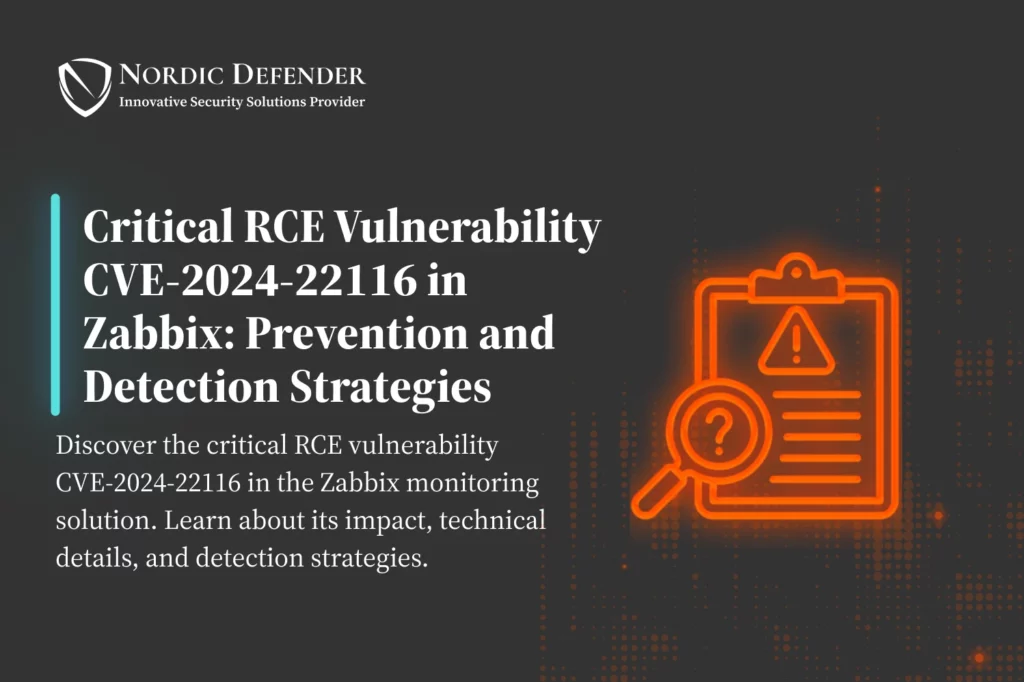A critical remote code execution (RCE) vulnerability, identified as CVE-2024-22116, has been discovered in the Zabbix monitoring solution. This vulnerability allows attackers to execute arbitrary code, posing a severe threat to IT infrastructures. In this article, we delve into the technical details of the vulnerability, its impact, and the measures to mitigate and detect such threats.
Technical Details of CVE-2024-22116
The CVE-2024-22116 vulnerability is rooted in the script execution functionality within the Monitoring Hosts section of Zabbix. Specifically, the flaw arises from the improper handling of script parameters, which are not adequately escaped by default. This oversight allows an attacker with restricted administrative permissions to inject malicious code via the Ping script.
Exploit Mechanism of CVE-2024-22116
- Parameter Injection: The attacker leverages the lack of input validation and escaping mechanisms to inject arbitrary code into the script parameters.
- Script Execution: The injected code is executed within the context of the Zabbix server, allowing the attacker to perform unauthorized actions.
- Privilege Escalation: By exploiting this vulnerability, the attacker can escalate their privileges and gain control over the entire Zabbix infrastructure.
Impact and Risks of CVE-2024-22116
The exploitation of CVE-2024-22116 can lead to several severe outcomes, including:
- Unauthorized Access: Attackers can gain unauthorized access to sensitive data and systems.
- Data Breaches: Compromised systems can result in data breaches, exposing confidential information.
- Service Disruption: The execution of arbitrary code can disrupt critical monitoring services, leading to downtime and operational inefficiencies.
- Infrastructure Compromise: The entire IT infrastructure monitored by Zabbix can be compromised, allowing attackers to move laterally and escalate their attacks.
Strategies to Prevent CVE-2024-22116
- Update Zabbix: Upgrade to the latest versions, 6.4.16rc1 or 7.0.0rc3, where the vulnerability has been patched.
- Input Validation: Implement robust input validation and escaping mechanisms for all script parameters to prevent code injection.
- Access Control: Enforce strict access control policies, limiting administrative permissions to trusted personnel only.
- Security Patches: Regularly apply security patches and updates to all software components within the infrastructure.
Detection Solutions for CVE-2024-22116
- Intrusion Detection Systems (IDS): Deploy IDS to monitor network traffic for signs of exploitation attempts and suspicious activities.
- Log Analysis: Implement comprehensive log analysis to detect anomalies and unauthorized access attempts.
- Vulnerability Scanning: Utilize automated vulnerability scanning tools to identify and remediate security flaws in real-time.
- Threat Intelligence: Leverage threat intelligence services to stay informed about emerging threats and vulnerabilities, enabling proactive defense measures.
Conclusion
The CVE-2024-22116 vulnerability in Zabbix highlights the critical importance of proactive cybersecurity measures. By understanding the technical details of the vulnerability and implementing robust prevention and detection strategies, organizations can safeguard their infrastructures against potential threats.
For more information and assistance, contact our cybersecurity experts at Nordic Defender. Together, we can build a secure and resilient digital environment.
